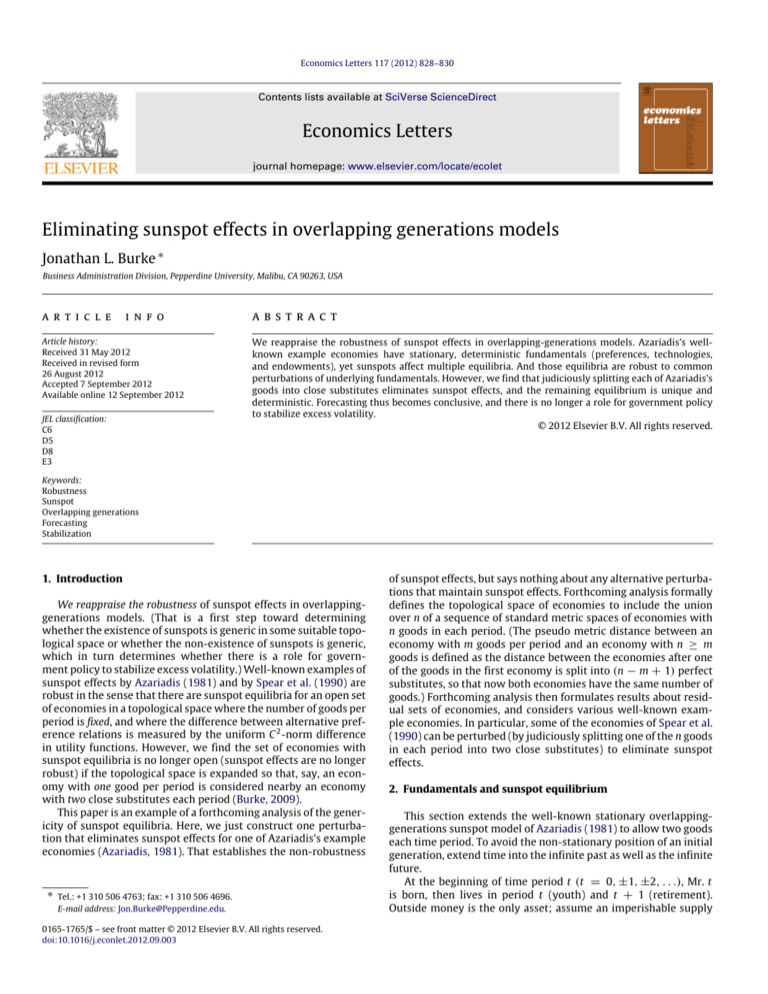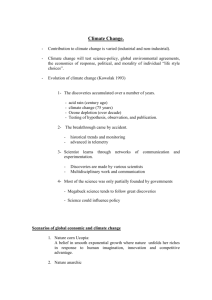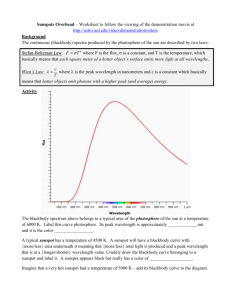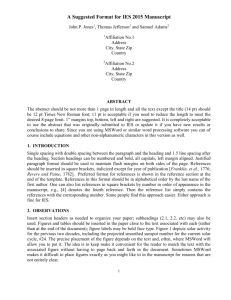
Economics Letters 117 (2012) 828–830
Contents lists available at SciVerse ScienceDirect
Economics Letters
journal homepage: www.elsevier.com/locate/ecolet
Eliminating sunspot effects in overlapping generations models
Jonathan L. Burke ∗
Business Administration Division, Pepperdine University, Malibu, CA 90263, USA
article
info
Article history:
Received 31 May 2012
Received in revised form
26 August 2012
Accepted 7 September 2012
Available online 12 September 2012
JEL classification:
C6
D5
D8
E3
abstract
We reappraise the robustness of sunspot effects in overlapping-generations models. Azariadis’s wellknown example economies have stationary, deterministic fundamentals (preferences, technologies,
and endowments), yet sunspots affect multiple equilibria. And those equilibria are robust to common
perturbations of underlying fundamentals. However, we find that judiciously splitting each of Azariadis’s
goods into close substitutes eliminates sunspot effects, and the remaining equilibrium is unique and
deterministic. Forecasting thus becomes conclusive, and there is no longer a role for government policy
to stabilize excess volatility.
© 2012 Elsevier B.V. All rights reserved.
Keywords:
Robustness
Sunspot
Overlapping generations
Forecasting
Stabilization
1. Introduction
We reappraise the robustness of sunspot effects in overlappinggenerations models. (That is a first step toward determining
whether the existence of sunspots is generic in some suitable topological space or whether the non-existence of sunspots is generic,
which in turn determines whether there is a role for government policy to stabilize excess volatility.) Well-known examples of
sunspot effects by Azariadis (1981) and by Spear et al. (1990) are
robust in the sense that there are sunspot equilibria for an open set
of economies in a topological space where the number of goods per
period is fixed, and where the difference between alternative preference relations is measured by the uniform C 2 -norm difference
in utility functions. However, we find the set of economies with
sunspot equilibria is no longer open (sunspot effects are no longer
robust) if the topological space is expanded so that, say, an economy with one good per period is considered nearby an economy
with two close substitutes each period (Burke, 2009).
This paper is an example of a forthcoming analysis of the genericity of sunspot equilibria. Here, we just construct one perturbation that eliminates sunspot effects for one of Azariadis’s example
economies (Azariadis, 1981). That establishes the non-robustness
∗
Tel.: +1 310 506 4763; fax: +1 310 506 4696.
E-mail address: Jon.Burke@Pepperdine.edu.
0165-1765/$ – see front matter © 2012 Elsevier B.V. All rights reserved.
doi:10.1016/j.econlet.2012.09.003
of sunspot effects, but says nothing about any alternative perturbations that maintain sunspot effects. Forthcoming analysis formally
defines the topological space of economies to include the union
over n of a sequence of standard metric spaces of economies with
n goods in each period. (The pseudo metric distance between an
economy with m goods per period and an economy with n ≥ m
goods is defined as the distance between the economies after one
of the goods in the first economy is split into (n − m + 1) perfect
substitutes, so that now both economies have the same number of
goods.) Forthcoming analysis then formulates results about residual sets of economies, and considers various well-known example economies. In particular, some of the economies of Spear et al.
(1990) can be perturbed (by judiciously splitting one of the n goods
in each period into two close substitutes) to eliminate sunspot
effects.
2. Fundamentals and sunspot equilibrium
This section extends the well-known stationary overlappinggenerations sunspot model of Azariadis (1981) to allow two goods
each time period. To avoid the non-stationary position of an initial
generation, extend time into the infinite past as well as the infinite
future.
At the beginning of time period t (t = 0, ±1, ±2, . . .), Mr. t
is born, then lives in period t (youth) and t + 1 (retirement).
Outside money is the only asset; assume an imperishable supply
J.L. Burke / Economics Letters 117 (2012) 828–830
of 1. Consumption goods are perishable; good type 1 is available in
the first half of a time period, and type 2 in the second half.
Mr. t generates utility u(ct +1 , nt ) from the two types of retirement consumption ct +1 = (ct +1,1 , ct +1,2 ) ∈ ℜ2+ and two types of
youthful labor supplied nt = (nt1 , nt2 ) ∈ ℜ2+ . The consumption
good is produced at constant returns to scale using labor, with 1
labor unit producing 1 consumption unit. Endow the young with
1/2 divisible unit of each type of labor.
Under rational expectations, consumers know future prices
may depend on sunspots. To fix the stochastic sunspot process, let
Ωt be a finite
t set of conceivable sunspot types realized at time t,
and Ω t = −∞ Ω t be the set of conceivable histories up through
time t. Assume a common probability belief π (st +1 |st ) > 0 of each
sunspot type st +1 ∈ Ωt +1 conditional on each history st ∈ Ω t .
Each period’s sunspot type is revealed to everyone before
production and trade occurs. Hence, Mr. t’s production yt is a
function of history up through time t, and consumption ct +1 is a
function of history through t + 1. Expected utility conditional on
history st ∈ Ω t is thus
E u(ct +1 , yt )|st
:=
π (st +1 |s ) u(ct +1 (st +1 , s ), yt (s )).
t
t
t
(1)
st +1 ∈Ωt +1
There, pairing sunspot st +1 ∈ Ωt +1 at t + 1 with history s ∈ Ω
through t forms history st +1 = (st +1 , st ) ∈ Ω t +1 through t + 1.
A rational expectations equilibrium for utility u(ct +1 , nt ) is a time
path of goods prices pt : Ω t → ℜ2+ , of outputs yt : Ω t → ℜ2+ , and
of consumptions ct : Ω t → ℜ2+ that satisfy, for each time period
t = 0, ±1, . . . ,
t
t
(R1) For each history st ∈ Ω t , output yt (st ) ∈ ℜ2+ and the consumption function ct +1 (·, st ) : Ωt +1 → ℜ2+ solve
max E u(ct +1 , yt )|st
(R2) (Goods market clearing) ct +1 = yt +1
(R3) (Money market clearing) pt · yt = 1.
Assumption. Ωt contains a single type for time periods before one,
and Ωt contains at least two types after one.
Because Ωt is a singleton for time periods before one, all equilibria initially exhibit perfect foresight. Equilibrium analysis is thus
about whether sunspots can begin to matter, not about whether
sunspots can continue to matter.
3. Perturbing away sunspot effects
This section perturbs away sunspot effects for a representative
of Azariadis’s example economies (Azariadis, 1981). Those examples have one aggregate good available each time period, so specialize the definitions from Section 2.
The aggregated economy consists of a one unit labor endowment, and a separable bivariate utility function
3
for parameter ȳ = 2/3.
∂v
(c , n) = c −3 and
∂c
∂v
G(n) := −n
(c , n) = ȳ−5 n2
∂n
U (c ) := c
(3)
as in Azariadis (1981, Eq. 2). Hence, first-order conditions for
constrained utility maximization (R1) reduce perfect foresight
equilibrium conditions to
U (yt +1 ) ≥ G(yt ) and
yt ∈ (0, 1],
with equality if yt < 1. (4)
Evidently, the only stationary solution yt +1 = yt to that difference
equation (4) is yt = ȳ. And {ȳ} is the only solution path {yt } such
that y0 = ȳ. Observation 2. The aggregated economy (2) has multiple sunspot
equilibria such that y0 = ȳ.
To see Observation 2, note the auxiliary functions (3) satisfy
Azariadis’s sufficient conditions for the existence of sunspot equilibria (Azariadis, 1981, Section II): future consumption and current
leisure are local gross complements (U ′ (ȳ) < 0) and the equilibrium difference equation (4) is locally stable (|U ′ (ȳ)| > |G′ (ȳ)|).
Hence, multiple output paths {yt } are consistent with sunspot
equilibria. For example, one path varies with period 1 sunspot
types α, β ∈ Ω1 :
(S1) yt = ȳ, for t = 0, −1, −2, . . .
(S2) y1 (α) = 1/2 and y1 (β) = 3/4, for t = 1
(S3) yt (α) = f t −1 (y1 (α)) and yt (β) = f t −1 (y1 (β)), for t = 2,
3, 4, . . .
(S4) π (α)U (y1 (α)) + (1 − π (α))U (y1 (β)) = G(ȳ).
There, pt are time t goods prices in terms of money. The constraint
yt (st ) ∈ [0, 1/2]2 ensures labor does not exceed the 1/2 unit endowment of each type of labor.
A ‘‘rational expectations’’ equilibrium is a perfect foresight equilibrium if every function pt , yt , ct is constant (consumers know the
future with certainty); otherwise, it is a sunspot equilibrium.
v(ct +1 , nt ) := − (ct +1 )
There, ȳ is the parameter from the definition of utility (2).
To see Observation 1, compute auxiliary functions
−2/3
∀ s t +1 ∈ Ωt +1
yt (st ) ∈ [0, 1/2]2
−3
Observation 1. The aggregated economy (2) has a single stationary
perfect foresight equilibrium,1 with consumption and production ct =
yt = ȳ and prices pt = ȳ−1 . And that is the only perfect foresight
equilibrium such that y0 = ȳ.
over yt ∈ [0, 1].
for the transition function f (yt ) := ȳ5/3 yt
(Both y1 (α) = 1/2 and y1 (β) = 3/4 are in the stable set [ȳ5/2 , 1]
of that transition function.) Define sunspot probabilities π (α) and
1 − π (α) by the auxiliary functions (Azariadis, 1981, Eq. 11):
s.t. pt +1 (st +1 , st ) · ct +1 (st +1 , st ) = pt (st ) · yt (st ),
1
829
1
− ȳ−5 (nt )2 ,
2
(2)
Other examples allow long-run stationary sunspot cycles (Azariadis, 1981, Section II). Observation 1 says the perfect-foresight equilibrium is conditionally determinate: if the economy initially follows the stationary perfect foresight equilibrium path, then the future equilibrium
stays on that path. Observation 2 overturns such ‘‘conditional determinacy’’, with a deterministic perfect foresight equilibrium path
(S1) followed by a sunspot equilibrium path (S2) and (S3). Hence,
we perturb the aggregated economy (2) from Observation 2 to
eliminate sunspot effects and establish conditional determinacy
for rational expectations equilibria. Following Burke (2009), the
perturbation will disaggregate the single good into close substitutes.2
One underlying implicit assumption in any general-equilibrium
model with a fixed number of goods available is that, if any one of
the goods were disaggregated into two (or more) goods, then those
disaggregated goods must be perfect substitutes. Thus Azariadis
1 Our use of money as numéraire (R3) excludes the trivial perfect foresight
equilibrium where money is worthless, and consumption and production are
always zero.
2 Burke (2009) uses disaggregation to perturb away indeterminate perfect
foresight equilibria. The Burke (2009) class of models is different from ours, the
perturbation is different, and the results are different: we perturb away all but one
equilibrium path, while Burke (2009) restricts attention to local analysis and allows
an infinite number of alternative paths to remain in a neighborhood of the historic
equilibrium path.
830
J.L. Burke / Economics Letters 117 (2012) 828–830
implicitly assumes his aggregated model (2) is equivalent to a
disaggregated version.
The disaggregated economy consists of an endowment of 1/2
unit in youth of each of the two types of labor, and a utility function
1
1
u(ct +1 , nt ) := − (ct +1,1 + ct +1,2 )−3 −
(nt1 + nt2 )2
3
2ȳ5
(5)
over consumption ct +1 = (ct +1,1 , ct +1,2 ) ∈ ℜ2+ and labor nt =
(nt1 , nt2 ) ∈ ℜ2+ .
There is an evident equivalence of the equilibria of the disaggregated economy (5) and the unique equilibrium (Observation 1)
of the aggregated economy (2).
Observation 3. The disaggregated economy (5) has an infinite
number of stationary perfect foresight equilibria, indexed ct = yt =
(γ1 , γ2 ) and pt = (1/ȳ, 1/ȳ), for parameters (γ1 , γ2 ) ∈ [1/6, 1/2]2
such that γ1 + γ2 = ȳ.
Observation 3 says prices are equal for the two perfect substitutes in the disaggregated economy (5), and the distribution of consumption between substitutes is indeterminate. Henceforth, fix
any one of the stationary output solutions (γ1 , γ2 ) from Observation 3. Without loss of generality, assume γ1 < 1/2.
A perturbed economy has the same endowments as the disaggregated economy (5) but a different utility function (6).
Observation 4. For sufficiently large k, the perturbed utility function
uk := u −
1
k
ψ,
for polynomial ψ(ct +1 , nt ) := (n2t2 + 1) ∥ct +1 − (γ1 , γ2 )∥2
The theorem says each perturbed economy lacks the sunspot
equilibria that Observation 2 finds for the aggregated economy (2).
The convergence of the sequence of perturbed economies to the
disaggregated economy (5) thus proves those sunspot effects are
fragile.
To prove the theorem, fix any perturbed economy uk (6). The
perfect foresight equilibrium ct = yt = (γ1 , γ2 ) and pt = (ȳ−1 ,
ȳ−1 ) from Observation 3 for the disaggregated economy (5) is
also an equilibrium for the perturbed economy (6) because, at
ct = yt = (γ1 , γ2 ), utility functions u and uk have the same first
derivatives (6), and so satisfy the same first-order conditions for
utility maximization (R1).
To prove uniqueness for the perturbed economy, consider any
alleged rational expectations equilibrium paths {pt } , {yt } , {ct }
such that y0 = (γ1 , γ2 ) and p0 = (ȳ−1 , ȳ−1 ).
Keep Mr. 0’s retirement consumption c1 on the equilibrium
path, but consider changing youthful output from y0 to yε := y0 +
(ε, −ε), for ad hoc parameter ε ≥ 0. γ1 ∈ [1/6, 1/2) and γ2 ∈
[1/6, 1/2] imply, for sufficiently small ε, output yε ∈ [0, 1/2]2 and
the consumption function c1 (·, s0 ) : Ω1 → ℜ2+ are feasible for Mr.
0’s utility maximization problem (R1) at prices p0 = (ȳ−1 , ȳ−1 ).
Hence, Mr. 0’s solution at equilibrium y0 implies a non-positive
marginal utility
0≥
∂ k
E u (c1 , yε )|s0 .
ε=0
∂ε
Computing that derivative (1), (5) and (6) yields
∂ k
2γ2
=
E u (c1 , yε )|s0
E ∥c1 − (γ1 , γ2 )∥2 s0 .
ε=0
∂ε
k
Hence, γ2 > 0 implies E ∥c1 − (γ1 , γ2 )∥2 s0 = 0, which implies c1 = (γ1 , γ2 ) in every sunspot state s1 ∈ Ω1 since conditional
probability π (s1 |s0 ) > 0. Hence, goods market clearing (R2) implies y1 = (γ1 , γ2 ). Finally, c1 = (γ1 , γ2 ) implies utility functions u
0≥
(6)
is concave, increasing in ct +1 , and decreasing in nt when restricted to
feasible consumption ct +1 ∈ [0, 1]2 and labor nt ∈ [0, 1/2]2 . And
uk can be extended to have the latter three properties over all nonnegative consumption and labor.
In Observation 4, u is the disaggregated version (5) of the
aggregated utility function (2).
Keeping endowments fixed, measure the metric distance
d(uk , u) between perturbed utility functions (6) and the disaggregated utility function (5) by the C 2 -norm difference in utility
restricted to feasible consumption. In particular, Observation 4 implies d(uk , u) → 0. Hence, measure the distance d̃(uk , v) between
perturbed utility functions (6) and the aggregated utility function
(2) as d̃(uk , v) := d(uk , u). Hence, d(uk , u) → 0 implies the sequence of perturbed economies (6) converges to the aggregated
economy (2). Our main result is that each of those perturbations
eliminate the sunspot effects from the aggregated economy (2).
Theorem. Each perturbed economy (6) has a single stationary perfect
foresight equilibrium, with consumption and production ct = yt =
(γ1 , γ2 ) and prices pt = (ȳ−1 , ȳ−1 ). And that is the only rational expectations equilibrium such that y0 = (γ1 , γ2 ) and p0 = (ȳ−1 , ȳ−1 ).
and uk have the same first derivatives (6), and so y0 and c1 can only
maximize utility uk (R1) if period 1 prices in vector p1 are equal
for the two substitute goods. Hence, money market clearing (R3)
implies p1 = (ȳ−1 , ȳ−1 ).
Putting it all together, y0 = (γ1 , γ2 ) and p0 = (ȳ−1 , ȳ−1 ) at time
0 imply y1 = (γ1 , γ2 ) and p1 = (ȳ−1 , ȳ−1 ) at every sunspot history
s1 ∈ Ω 1 . Repeating that argument implies yt = (γ1 , γ2 ) and pt =
(ȳ−1 , ȳ−1 ) at every sunspot history st ∈ Ω t . Hence, that perfect
foresight equilibrium is the only rational expectations equilibrium
such that y0 = (γ1 , γ2 ) and p0 = (ȳ−1 , ȳ−1 ) at time 0. References
Azariadis, C., 1981. Self-fulfilling prophecies. Journal of Economic Theory 25,
380–396.
Burke, J., 2009. Virtual determinacy in overlapping generations models. Econometrica 77, 235–247.
Spear, Stephen E., Srivastava, Sanjay, Woodford, Michael, 1990. Indeterminacy of
stationary equilibrium in stochastic overlapping generations models. Journal of
Economic Theory 50, 265–284.






